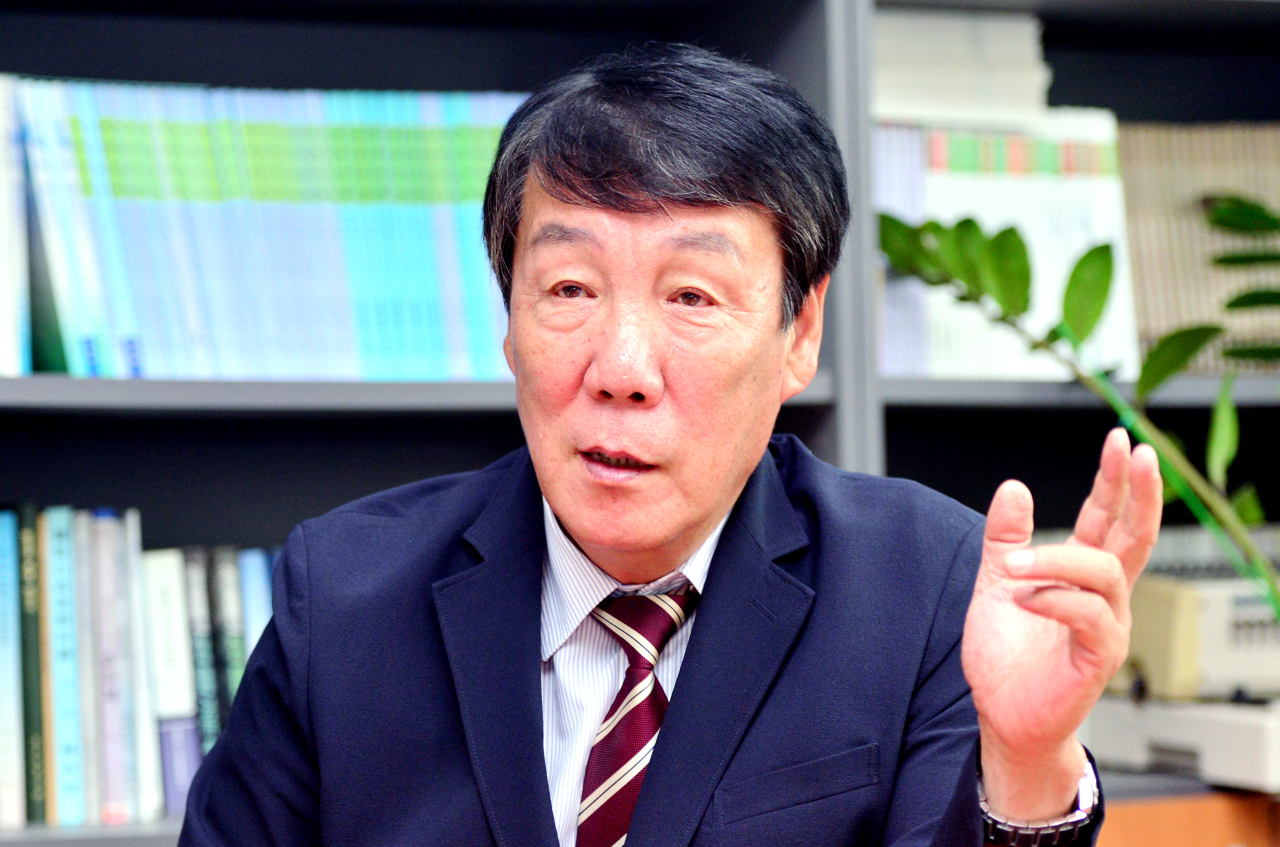 |
Leem Ho-young, former deputy commander of the Republic of Korea-US Combined Forces Command, speaks during an interview with The Korea Herald at his office in Yongsan, central Seoul. (Park Hyun-koo/The Korea Herald) |
South Korea and the US should not miss a rare opportunity to gradually turn North Korea into their ally by helping out Pyongyang, which is desperate to find a way out of its worst economic crisis, said Leem Ho-young, former deputy commander at the allies’ Combined Forces Command.
“Let’s think beyond denuclearization. We have to eventually bring North Korea to the alliance-led order. That’s the ‘Grand Bargain,’” the retired four-star Army general said in an interview with The Korea Herald. He was referring to an article he contributed to the US publication Foreign Affairs in late July.
There, Leem and retired Gen. Vincent Brooks, who served with him as commander in 2016 and 2017, proposed bringing North Korea to what they called an “alliance-led order” as denuclearization and normalization of ties took place in stages.
The first two steps would involve offering humanitarian aid and signing a declaration formally ending the 1950-53 Korean War. The next two steps are more contentious: The South and the US should step up their economic commitments to the North and replace the armistice agreement with a peace treaty.
Proportionate measures, concessions and demonstrated progress by Pyongyang should accompany each step in what Leem calls “strategic deliberateness,” which means mutual trust would be a precondition for deeper collaboration. The allies would maintain defense readiness until trust was built, he said.
The Korea Herald: Your pitch doesn’t seem new. What makes you think it will work?
Leem Ho-young: Timing. North Korea wants help with its economy now more than ever, and that’s a sign our help would work this time if we offer it. North Korean leader Kim Jong-un fears social upheaval caused by economic distress and understands that’s a threat to his rule. He wants engagement. He has been careful with his language on US President Joe Biden. In October last year, Pyongyang showed off a new intercontinental ballistic missile, but it didn’t call Washington an imperialist aggressor or sworn enemy as it did the previous time, in September 2018.
KH: Who does what in this economic initiative and what’s the goal?
LEEM: The US should put together a multinational infrastructure development fund to offer the North a 10-year interest-free loan, while the South should pursue a free trade pact with the North. The plan is to reduce the North’s dependence on China, and to eventually bring the regime closer to the South-US alliance order. Pyongyang would have to work on denuclearization along the way. If it doesn’t, we won’t deliver either.
For this to work, we need a long-term, coherent North Korea policy that could survive political shifts. But that hasn’t been the case for South Korea. We really need to start thinking long-term.
KH: Do you see China getting on board with this proposal?
LEEM: The fact the US and China are not on favorable terms means the US has more to gain than to lose in trying this economic initiative. It draws Pyongyang closer to its side and away from Beijing, which will work to Washington’s advantage when it is seeking to put checks on Beijing. We will have to make the US see this initiative is worth giving a shot to avoid being trapped in the current unacceptable status quo.
And the US won’t just sit and watch Beijing extending its lifeline to Pyongyang, because that only reinforces its influence over the regime.
KH: How will this economic plan link the North to the South-US alliance order?
LEEM: Given the economic project is up and running, we’ll have to look at if the North has become nuclear-free, and if the two Koreas cannot risk invading each other. If that’s yes, we can look to ink a peace treaty. Our defense readiness shouldn’t be compromised along the way. By the time the two Koreas reach a peace agreement, South Korea will be the leading provider of North Korea’s investment, with the US being the second-leading partner responsible for the North’s international financing. Pyongyang will find itself in a wider Indo-Pacific trade pact.
What sets all of that in motion is if North Korea joins the economic initiative in the first place. North Koreans heavily rely on “jangmadang” (North Korea’s black markets, which now account for almost 60 percent of the economy), which tells us there is room for capitalism to expand.
KH: How is this economic agenda any different from the Moon Jae-in government’s approach?LEEM: Two things. What is it that the Moon administration is trying to ultimately achieve through economic engagement? That has been unclear. Has the government ever called out North Koreans on something they’ve done wrong? I don’t think so.
Moon seeks engagement for engagement and there has been no change since the 2018 inter-Korean summits where the two Koreas shook hands on denuclearization. The government was business as usual when North Koreans killed our fisheries official in September last year.
What’s worse is North Koreans got us thinking that the annual military drills between Seoul and Washington now threaten inter-Korean peace efforts. Talks took place many times in the past despite the drills. North Koreans have learned to get their way, and we’ve let them.
By Choi Si-young (
siyoungchoi@heraldcorp.com)





![[Exclusive] Hyundai Mobis eyes closer ties with BYD](http://res.heraldm.com/phpwas/restmb_idxmake.php?idx=644&simg=/content/image/2024/11/25/20241125050044_0.jpg)

![[Herald Review] 'Gangnam B-Side' combines social realism with masterful suspense, performance](http://res.heraldm.com/phpwas/restmb_idxmake.php?idx=644&simg=/content/image/2024/11/25/20241125050072_0.jpg)
